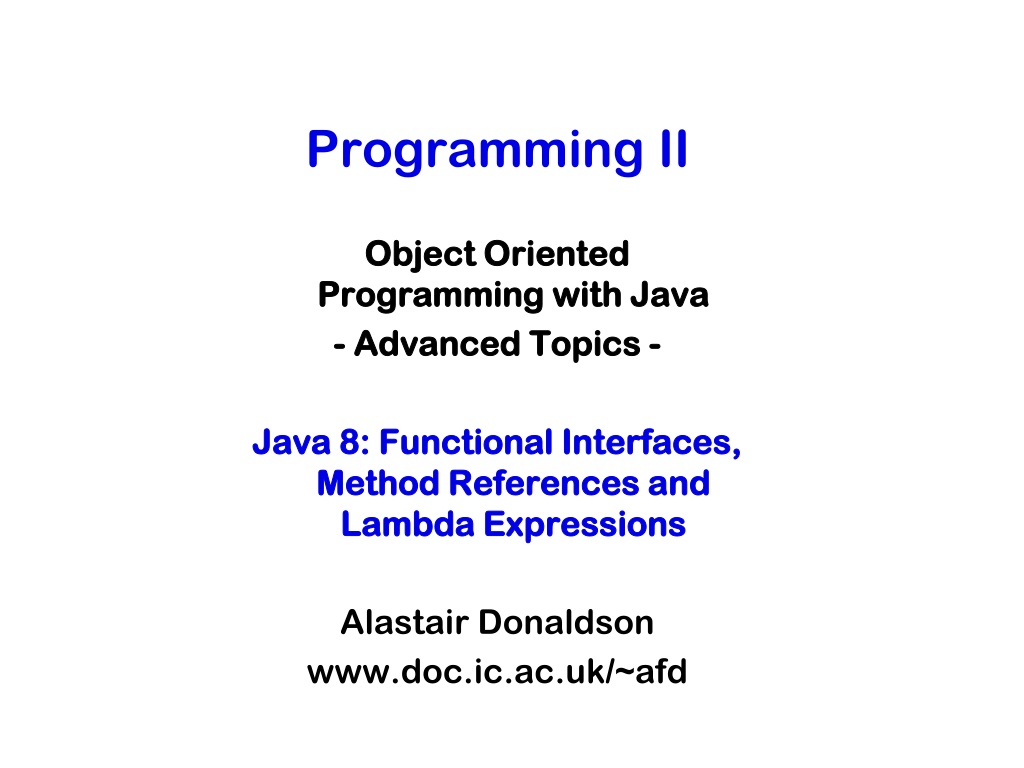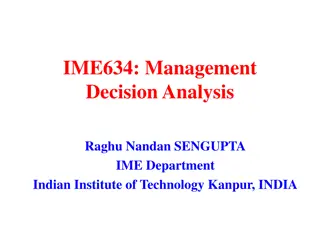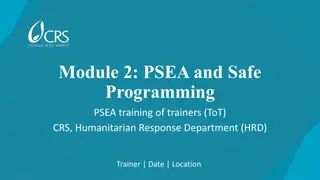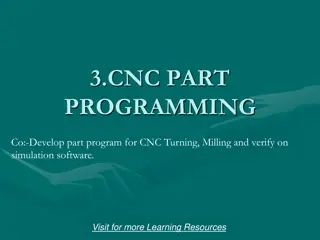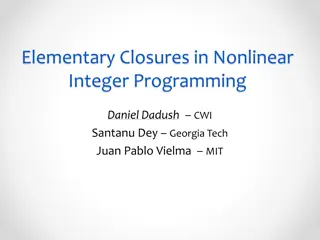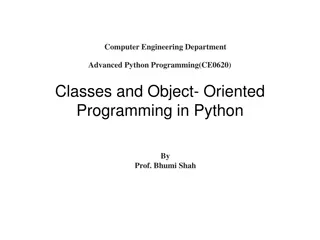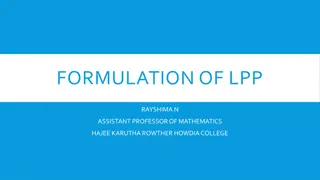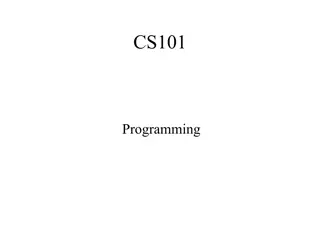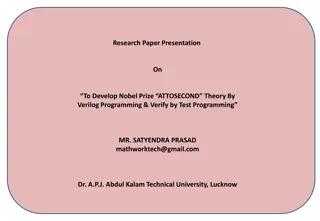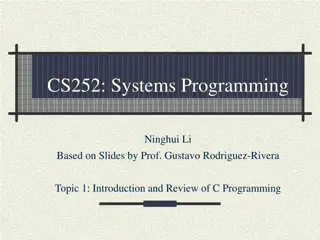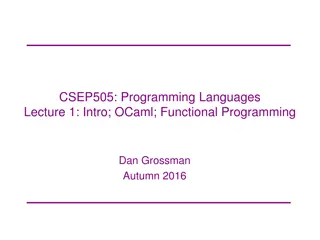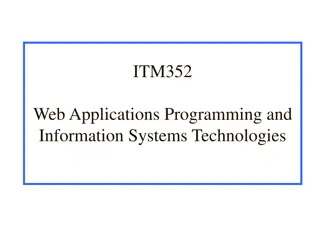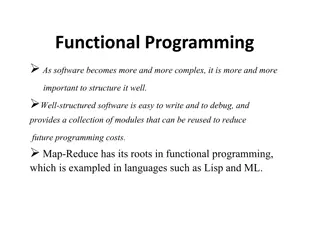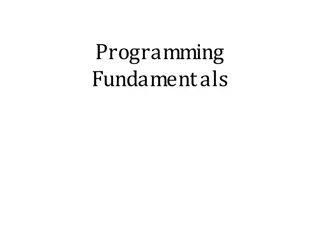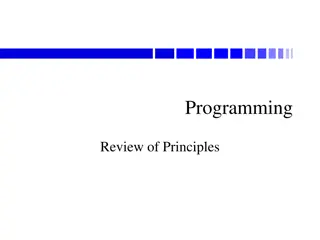Programming II
In this content, we delve into advanced Java concepts such as Functional Interfaces, Method References, and Lambda Expressions. We compare Java programming techniques with those from Haskell, showcasing how to manipulate lists and elements. The exploration includes practical code examples, critiques, and an innovative approach using Transformer interfaces in Java.
Download Presentation

Please find below an Image/Link to download the presentation.
The content on the website is provided AS IS for your information and personal use only. It may not be sold, licensed, or shared on other websites without obtaining consent from the author.If you encounter any issues during the download, it is possible that the publisher has removed the file from their server.
You are allowed to download the files provided on this website for personal or commercial use, subject to the condition that they are used lawfully. All files are the property of their respective owners.
The content on the website is provided AS IS for your information and personal use only. It may not be sold, licensed, or shared on other websites without obtaining consent from the author.
E N D
Presentation Transcript
Programming II Object Oriented Object Oriented Programming with Java Programming with Java - - Advanced Topics Advanced Topics - - Java 8: Functional Interfaces, Java 8: Functional Interfaces, Method References and Method References and Lambda Expressions Lambda Expressions Alastair Donaldson www.doc.ic.ac.uk/~afd
Remember good old map from Haskell? map :: (a -> b) -> [a] -> [b] Multiply each list element by 10 Prelude> map (\x -> 10*x) [0..9] [0,10,20,30,40,50,60,70,80,90] Convert each list element to a float Prelude> map (\x -> 1.0*x) [0..9] [0.0,1.0,2.0,3.0,4.0,5.0,6.0,7.0,8.0,9.0] Raise list element x to a three-element list [x-1, x, x + 1] Prelude> map (\x -> [x-1, x, x+1]) [0..9] [[-1,0,1],[0,1,2],[1,2,3],[2,3,4],[3,4,5],[4,5,6],[5,6,7], [6,7,8],[7,8,9],[8,9,10]] Let s try to do this in Java 2
Attempt 1: three separate loops Make the list [0..9] public class JustLoops { public static void main(String[] args) { List<Integer> integers = new ArrayList<Integer>(); for(int i = 0; i < 10; i++) { integers.add(i); } Multiply elements by ten List<Integer> tenTimesBigger = new ArrayList<Integer>(); for(Integer i : integers) { tenTimesBigger.add(10*i); } System.out.println(tenTimesBigger); Turn elements into floats List<Float> floats = new ArrayList<Float>(); for(Integer i : integers) { floats.add(new Float(i)); } System.out.println(floats); 3
Attempt 1: three separate loops ... List<List<Integer>> triples = new ArrayList<>(); for(Integer i : integers) { triples.add(Arrays.asList(new Integer[] { i-1, i, i+1 })); } System.out.println(triples); } Raise each element to a triple } Program output: [0, 10, 20, 30, 40, 50, 60, 70, 80, 90] [0.0, 1.0, 2.0, 3.0, 4.0, 5.0, 6.0, 7.0, 8.0, 9.0] [[-1, 0, 1], [0, 1, 2], [1, 2, 3], [2, 3, 4], [3, 4, 5], [4, 5, 6], [5, 6, 7], [6, 7, 8], [7, 8, 9], [8, 9, 10]] 4
Critique of Attempt 1 Produces the same effect as the Haskell program but the map logic is re-implemented each time Not satisfactory 5
Attempt 2: a Transformer interface Haskell s map takes a function that transforms something of type a into something of type b: map :: (a -> b) -> [a] -> [b] Let s write map in Java, in terms of an interface that can transform something of type a into something of type b but we re in Java mode, so we ll use S and T, not a and b 6
Transformer interface The interface is generic with respect to types S and T public interface Transformer<S, T> { public T transform(S x); } transformsays: give me an S and I will give you back a T Let us write our three transformers 7
Three Transformer implementations Notice here that we provide concrete types for S and T when we implement Transformer public class TimesTenTransformer implements Transformer<Integer, Integer> { @Override public Integer transform(Integer x) { return x*10; } } implements Transformer<Integer, Float> { @Override public Float transform(Integer x) { return new Float(x); } } implements Transformer<Integer, List<Integer>> { @Override public List<Integer> transform(Integer x) { return Arrays.asList(new Integer[] { x - 1, x, x + 1 }); } } public class IntegerToFloatTransformer public class IntegerToTripleTransformer 8
Implementing map using the Transformer interface public interface Transformer<S, T> { public T transform(S x); public static <A, B> List<B> map(Transformer<A, B> transformer, List<A> input) { List<B> result = new ArrayList<>(); for(A a : input) { result.add(transformer.transform(a)); } return result; } In Java 8, an interface can have static methods This is good, because sometimes an interface is the most logical home for such a method Our map method is not specific to any particular transformer, so it makes sense for it to live in the interface } 9
Using map with our transformers public class UsingInterfaces { public static void main(String[] args) { List<Integer> integers = new ArrayList<Integer>(); for(int i = 0; i < 10; i++) { integers.add(i); } List<Integer> tenTimesBigger = Transformer.map( new TimesTenTransformer(), integers); System.out.println(tenTimesBigger); List<Float> floats = Transformer.map( new IntegerToFloatTransformer(), integers); System.out.println(floats); List<List<Integer>> triples = Transformer.map( new IntegerToTripleTransformer(), integers); System.out.println(triples); } } 10
Critique of approach 2 We succeeded in capturing the essence of map Generics played a nice role in making this work Painful: writing a separate class each time we need a transformer. Especially if we need a simple transformer and we only need it once 11
Approach 3: anonymous classes Instead of declaring TimesTenTransformer as a class: public class TimesTenTransformer implements Transformer<Integer, Integer> { @Override public Integer transform(Integer x) { return x*10; } } and then using this class: List<Integer> tenTimesBigger = Transformer.map( new TimesTenTransformer(), integers); we can declare the class at the point we wish to use it. We don t even need to give the class a name: it can be anonymous 12
An anonymous version of TenTimesTransformer List<Integer> tenTimesBigger = Transformer.map( new Transformer<Integer, Integer>() { @Override public Integer transform(Integer x) { return x*10; } } , integers); This declares a nameless class that implements the Transformer interface, and creates a single instance of this class 13
An anonymous version of IntegerToFloatTransformer List<Float> floats = Transformer.map( new Transformer<Integer, Float>() { @Override public Float transform(Integer x) { return new Float(x); } } , integers); Says: Make an instance of a class that implements the Transformer<Integer, Float> interface, by defining the transformmethod as follows 14
An anonymous version of IntegerToTripleTransformer Similar: List<List<Integer>> triples = Transformer.map( new Transformer<Integer, List<Integer>>() { @Override public List<Integer> transform(Integer x) { return Arrays.asList(new Integer[] { x - 1, x, x + 1 }); } }, integers); 15
Critique of approach 3 Arguably less painful than approach 2: we did not have to write a separate class file for each transformer. Instead we described the transformers on demand using anonymous classes. But the anonymous class syntax is pretty verbose! 16
Functional interfaces An interface is a functional interface if it declares exactly one abstract method. To implement a functional interface, a class just needs to provide the single abstract method. Transformer is a functional interface: - One abstract method: transform - Also one non-abstract, static method, map 17
Functional interfaces and method references Suppose a method expects a parameter of type I, where I is a functional interface. In Java 8: - Instead of passing an instance of a class that implements I - you can pass a method that matches the signature of the single abstract method associated with the functional interface 18
Approach 4: use method references map expects a Transformer as its first argument Transformer is a functional interface Instead of passing a Transformer<S, T> to map, we can pass any method that: - accepts a single argument of type S - returns something of type T 19
Passing timesTen as a method reference public class UsingMethodReferences { private static Integer timesTen(Integer x) { return x * 10; } public static void main(String[] args) { List<Integer> integers = ...; List<Integer> tenTimesBigger = Transformer.map( UsingMethodReferences::timesTen, integers); System.out.println(tenTimesBigger); } Write UsingMethodReferences::timesTen to refer to static method timesTen of UsingMethodReferences class } There is also syntax for getting a reference to an instance method of an object (look it up) 20
Passing toTriple as a method reference public class UsingMethodReferences { private static List<Integer> toTriple(Integer x) { return Arrays.asList(new Integer[] { x - 1, x, x + 1 }); } public static void main(String[] args) { Method reference List<Integer> integers = ...; List<List<Integer>> triples = Transformer.map( UsingMethodReferences::toTriple, integers); System.out.println(triples); } } 21
Passing Float constructor as a method reference public class UsingMethodReferences { public static void main(String[] args) { List<Integer> integers = ...; List<Float> floats = Transformer.map( Float::new, integers); System.out.println(floats); } } Float::new is a reference to the constructor Float(Integer x) Type inference is used to determine which constructor makes sense here 22
Critique of approach 4 Passing in Float::new as a method reference is pretty neat! It s not clear that passing in timesTen and toTriple as method references is worth it. They do such simple things; it s annoying to have to write a specially named method for each of them. 23
Functional interfaces and lambda expressions Suppose a method expects a parameter of type I, where I is a functional interface. In Java 8, instead of passing an instance of a class that implements I, or a method reference, you can pass in a lambda expression. A lambda expression describes a function that produces a result from some arguments. 24
Lambda expression: example Instead of passing map a reference to the timesTen method: List<Integer> tenTimesBigger = Transformer.map( UsingMethodReferences::timesTen, integers); we can instead pass a lambda expression: List<Integer> tenTimesBigger = Transformer.map(x -> x*10, integers); Means we do not have to define timesTen at all! Compactly describes a function which, given argument x, returns x*10 The term lambda comes from the Lambda Calculus 25
Approach 5: use lambdas public class UsingLambdas { public static void main(String[] args) { List<Integer> integers = ... List<Integer> tenTimesBigger = Transformer.map( x -> x*10, integers); System.out.println(tenTimesBigger); These are lambda expressions List<Float> floats = Transformer.map( Float::new, integers); System.out.println(floats); List<List<Integer>> triples = Transformer.map( x -> Arrays.asList(new Integer[] { x - 1, x, x + 1 }) , integers); System.out.println(triples); } 26 }
Critique of approach 5 Basically gives us the elegance of map in Haskell, but in Java. 27
Lets write a method to compose two transformers Input: a transformer from S to T, a transformer from T to U Output: the transformer from S to U obtained by composing the input transformers public static <S, T, U> Transformer<S, U> compose( Transformer<S, T> t1, Transformer<T, U> t2) { return (x -> t2.transform(t1.transform(x))); } Here we are returning a lambda expression. The caller of compose can then apply the lambda expression in the future 28
Composition in action public class Composition { public static <S, T, U> Transformer<S, U> compose( Transformer<S, T> t1, Transformer<T, U> t2) { return (x -> t2.transform(t1.transform(x))); } public static void main(String[] args) { List<Integer> integers = ...; Stores a reference to a lambda expression Transformer<Integer, List<Integer>> timesTenAndTriple = compose((x -> x*10), (x -> Arrays.asList(new Integer[] { x - 1, x, x + 1 })) ); List<List<Integer>> bigTriples = Transformer.map(timesTenAndTriple, integers); System.out.println(bigTriples); } } The stored lambda expression is applied 29
Composition in action Output: [[-1, 0, 1], [9, 10, 11], [19, 20, 21], [29, 30, 31], [39, 40, 41], [49, 50, 51], [59, 60, 61], [69, 70, 71], [79, 80, 81], [89, 90, 91]] 30
Summary Anonymous classes avoid the need to declare a named class when only a simple activity is required. A functional interface can be implemented in a more light-weight manner: by passing a method reference for the single abstract method. A lambda expression can be used in place of a method reference, leading to very concise code Take home message: none of this lets you do anything you could not already do. It simply allows more elegant and concise code 31
Next time A few more details about anonymous classes A discussion of default methods (a.k.a. defender methods) in Java 8. 32
